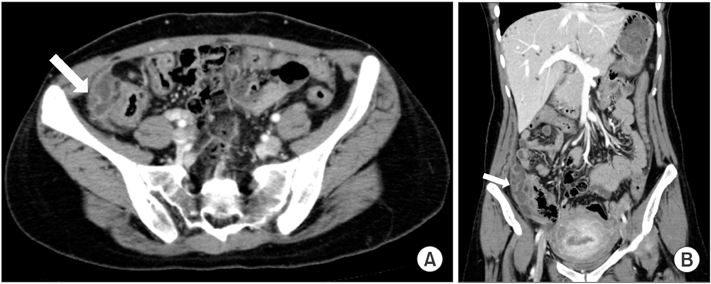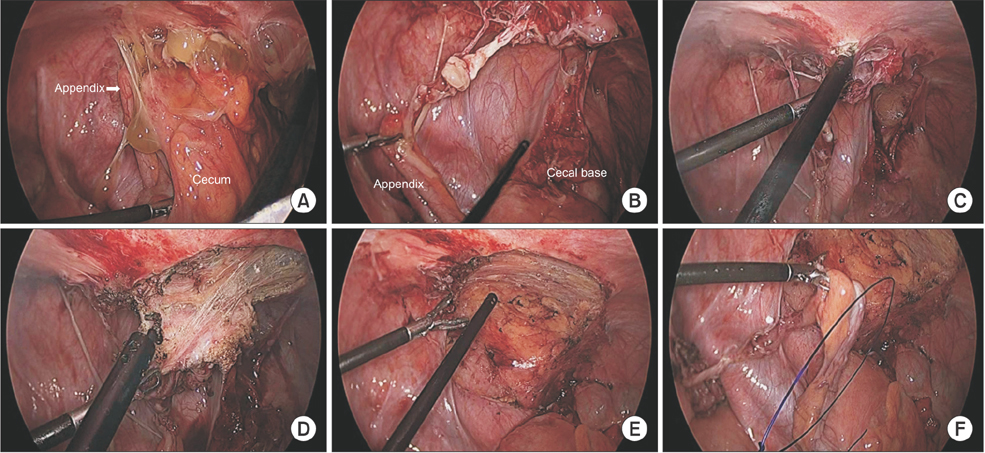Ann Surg Treat Res.
2015 Mar;88(3):170-173. 10.4174/astr.2015.88.3.170.
Complicated benign cystic mesothelioma of mesoappendix misdiagnosed as an appendiceal abscess in a postpartum period woman
- Affiliations
-
- 1Department of Surgery, Eulji General Hospital, Eulji University School of Medicine, Seoul, Korea.
- 2Department of Pathology, Eulji General Hospital, Eulji University School of Medicine, Seoul, Korea. taeil419@gmail.com
- KMID: 2266876
- DOI: http://doi.org/10.4174/astr.2015.88.3.170
Abstract
- Benign cystic mesothelioma is an uncommon tumor arising from the peritoneal mesothelium. It is characterized by multilocular grapelike, thin-, and translucent-walled cysts, or a unilocular cyst lined by benign mesothelial cells. It occurs predominantly in women of reproductive age, and shows a predilection for the surface of the pelvic peritoneum or visceral peritoneum. Patients usually present abdominal pain and palpable mass, but many cases have been found incidentally during laparotomy. Definite preoperative diagnosis is known to be difficult. Benign cystic mesothelioma has a tendency towards local recurrence, although the gross microscopic features are benign. Moreover, there is controversy over whether this disease is neoplastic or reactive. Initial complete surgical resection and cytoreductive surgery for recurred cases are standard treatments. In the following report, we describe a case of complicated benign cystic mesothelioma in a postpartum woman, involving the pelvic peritoneum and mesoappendix, which was initially misdiagnosed as a periappendiceal abscess.
Keyword
MeSH Terms
Figure
Reference
-
1. O'Connor DB, Beddy D, Aremu MA. Benign cystic mesothelioma of the appendix presenting in a woman: a case report. J Med Case Rep. 2010; 4:394.2. Ball NJ, Urbanski SJ, Green FH, Kieser T. Pleural multicystic mesothelial proliferation. The so-called multicystic mesothelioma. Am J Surg Pathol. 1990; 14:375–378.3. Weiss SW, Tavassoli FA. Multicystic mesothelioma. An analysis of pathologic findings and biologic behavior in 37 cases. Am J Surg Pathol. 1988; 12:737–746.4. Gonzalez-Moreno S, Yan H, Alcorn KW, Sugarbaker PH. Malignant transformation of "benign" cystic mesothelioma of the peritoneum. J Surg Oncol. 2002; 79:243–251.5. Suh YL, Choi WJ. Benign cystic mesothelioma of the peritoneum: a case report. J Korean Med Sci. 1989; 4:111–115.6. AbdullGaffar B, Keloth T. Mesoappendiceal and periappendiceal lesions. Pathol Res Pract. 2011; 207:137–141.7. McFadden DE, Clement PB. Peritoneal inclusion cysts with mural mesothelial proliferation: a clinicopathological analysis of six cases. Am J Surg Pathol. 1986; 10:844–854.8. Lim SC, Jeong YK, Lee MS, Kim YS, Park HJ, Choi SJ. Benign cystic mesothelioma. Korean J Pathol. 1997; 31:595–597.9. Letterie GS, Yon JL. The antiestrogen tamoxifen in the treatment of recurrent benign cystic mesothelioma. Gynecol Oncol. 1998; 70:131–133.10. Park BJ, Alexander HR, Libutti SK, Wu P, Royalty D, Kranda KC, et al. Treatment of primary peritoneal mesothelioma by continuous hyperthermic peritoneal perfusion (CHPP). Ann Surg Oncol. 1999; 6:582–590.
- Full Text Links
- Actions
-
Cited
- CITED
-
- Close
- Share
- Similar articles
-
- Multicystic mesothelioma of the peritoneum: case report
- Benign cystic mesothelioma of the peritoneum: a case report
- Benign Multicystic Mesothelioma in the Left Round Ligament: Case Report
- Torsion of Benign Cystic Teratoma of Ovary at 37 Weeks Gestation
- Cystic Lymphangioma Arising from the Mesoappendix: A Case Report




